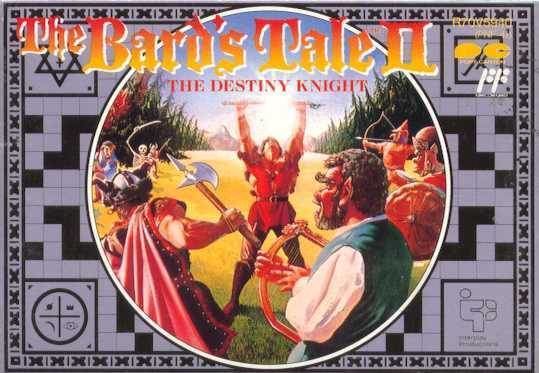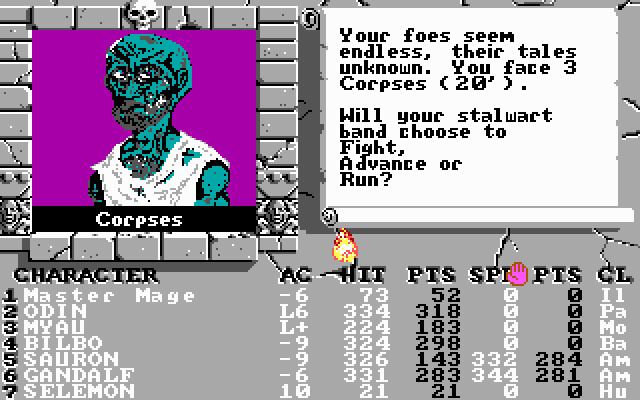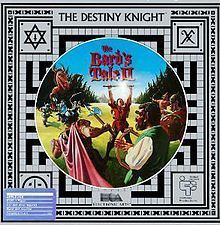8.4 /10 1 Votes8.4
Mode(s) Single player Series Bard's Tale | 4.2/5 My Abandonware Initial release date 1986 Developer Interplay Entertainment | |||||||||||||||||||||||||||||||||
 | ||||||||||||||||||||||||||||||||||
Genre(s) Role-playing video game Platforms Similar Bard's Tale games, Interplay Entertainment games, Role-playing video games | ||||||||||||||||||||||||||||||||||
The bard s tale ii the destiny knight commodore 64 intro
The Bard's Tale II: The Destiny Knight is a fantasy role-playing video game created by Interplay Productions in 1986. It is the first sequel to The Bard's Tale, and the last game of the series that was designed and programmed by Michael Cranford.
Contents
- The bard s tale ii the destiny knight commodore 64 intro
- Story
- Changes from The Bards Tale
- Characters
- Features
- Reception
- Designers
- References

The game features Dungeons and Dragons-style characters and follows in the footsteps of its predecessor, The Bard's Tale, also created by Michael Cranford.

The Bard's Tale II takes place on a larger scale with an explorable wilderness, six cities, and multiple dungeons which give this game its dungeon crawl character. The game has new features such as casinos and banks, and introduces a new magic user called an Archmage, among other changes from the first game in the series.

The game became somewhat infamous for its very high difficulty level. Cranford acknowledged this in interviews, stating that it may not have been playtested enough and that while he wanted to make a challenging game, he didn't realize just how difficult it was to complete the quest.

Although it received mixed reviews upon release, The Bard's Tale II won the Origins Award for Best Fantasy or Science Fiction Computer Game of 1986.
Story
As a beginning player, a wizard named Saradon, having heard the news of your victory over the evil wizard Mangar (in The Bard's Tale), contacts you with dire news: "Lawless mercenaries from the neighboring kingdom of Lestradae ... under the guidance of an evil Archmage known as Lagoth Zanta" have stolen the Destiny Wand, that, through its power, "has maintained peace and prosperity for the last 700 years".
The player's manual provides the following overview of the game:
As The Destiny Knight, you must assemble a band of adventurers, track down the seven pieces of the Destiny Wand, and defeat the evil Archmage, Lagoth Zanta. Once you have defeated the evil Archmage and have managed to collect all seven fragments of the Destiny Wand, you must reforge the scepter into a unified whole, thus reunifying the Realm (and winning the game).
Where the previous game took place in only one city, The Bard's Tale II features six smaller towns and a large wilderness area.
To complete the game, players must collect segments of the Destiny Wand. The wizard Saradon has informed the party that they are hidden in seven separate locations "within a Snare of Death—a puzzle room that will require all the wisdom and cunning at your disposal in order for you to survive". While the segments must not technically be retrieved in any particular order, the dungeons feature progressively more dangerous monsters which creates a de facto order for them:
To finish the game, an archmage in the party must take the seven segments to the Temple of Narn in the wilderness. The archmage reforges the segments into the Destiny Wand and becomes the Destiny Knight. But the game is not complete until Lagoth Zanta is defeated in the Sage's Hut.
Changes from The Bard's Tale
Although the "same interface and graphic display as the original game" (The Bard's Tale) are used in The Bard's Tale II, there are some noticeable changes. The world is a larger scale than The Bard's Tale. For example, instead of only one large city (Skara Brae), there are now six somewhat smaller towns: Colosse, Corinth, Ephesus, Philippi, Tangramayne, and Thessalonica. Players can explore a total of "25 dungeon levels" and the wilderness between cities. Michael R. Bagnall summarizes some of the other changes:
A new combat system now features ranged combat, so you'll need long-range weapons or magic to hit foes up to 90 feet away. This offers tactical challenges not present in the original game. There are also lots of new spells and Bard songs, plus a variety of fresh monsters and a special character class, the ArchMage.
In addition, there are now "Death Snare Puzzle Rooms" that have real-time time limits in the seven dungeons. "Some puzzles involve typing in passwords learned in other areas of a maze, while others require you to follow specific patterns while traversing a dungeon. Few can be solved by pure logic alone."
Players can also now summon multiple creatures to join the party. Additional new features include banks (where players can store money which will be available even if the party is defeated and the game is restarted), and casinos where players can try their luck at a blackjack-like game (not implemented in the PC version).
Characters
Characters can be imported from The Bard's Tale, Wizardry: Proving Grounds of the Mad Overlord (on Apple II versions), Ultima III: Exodus, or created from scratch and trained in Tangramayne's "starter maze".
Players can create a party of up to seven active characters; additional characters can be created and stored at the Adventurer's Guild in each city. They can be created as a human, elf, dwarf, hobbit, half-elf, half-orc, or gnome. Character classes available at the start are the warrior, paladin, rogue, bard, hunter, monk, conjurer, and magician. The sorcerer, wizard, and archmage classes are not available at the start. Character attributes (strength, intelligence, dexterity, constitution, and luck) are generated randomly during character creation (with values from 1–18) and affect gameplay. Empty character slots can also be filled with players or creatures through random encounters, spells, or the use of figurines.
Features
The Bard's Tale II has a number of features that were seen in The Bard's Tale. There are "unmarked buildings" that contain little except a possible monster encounter or the entryway to a dungeon or castle. Each city within the game has an Adventurers' Guild where characters can be created, parties saved, and other actions performed.
At Garth's Equipment Shoppe players can buy, sell, or identify items. Parties can withdraw saved money from an account at Bedder's Bank for the Bold and spend it gambling at a casino, playing a game similar to blackjack. A stint at a casino can be followed by a celebration (or players can drown their sorrow over a loss) at a tavern where various drinks are available and the bartender provides advice—for a price. When ready, a party can venture into a dungeon to explore, fight monsters, and gain the experience needed to advance levels and become powerful enough to complete their quest. After a return to town, parties may need to make a trip to a temple where characters can be healed, restoring hit points, levels, life force, youth, flesh (for characters turned to stone), or life itself. Roscoe's Energy Emporium is another useful stop, where spell casters can pay an exorbitant fee to have spell units restored. And when ready, characters can visit the Review Board to advance levels and change character classes (for magic users).
Reception
Scorpia of Computer Gaming World gave the game a mixed review. She noted several improvements over the original, such as an easier start and more easily recognizable buildings. However, the snares were considered excessively tedious, and the gameplay skewed heavily in favor of mages. Scorpia later called the game "without a doubt, the worst of the series", but the magazine's Charles Ardai called it "a fine sequel to Bard's Tale". RUN magazine reviewer Bob Guerra praised the game's new enemies and their corresponding animations and stated the game "offers an irresistible challenge to all fans of role-playing fantasies." Compute! stated that Bard's Tale II "lives up to its predecessor's excellent reputation". The magazine described the game as one "for the true adventure gamer. It is a very difficult and challenging game, and it requires great intestinal fortitude", and suggested that beginning adventurers avoid it.
The game was reviewed in 1987 in Dragon #120 by Hartley and Patricia Lesser in "The Role of Computers" column. The reviewers suggested that "If The Bard’s Tale was to your liking, then you’re going to absolutely go crazy for The Bard’s Tale II: The Destiny Knight."
Designers
Michael Cranford, a devout Christian, named five of the cities in the game after cities mentioned in the New Testament: Corinth, Colosse, Philippi, Ephesus, and Thessalonica. (He said in an interview that these were essentially placeholder names; he had fully expected them to be changed in the final game.) This was his last Bard's Tale game because he decided to go back to university to study philosophy and theology. Cranford had had a falling-out with Brian Fargo over his contract for The Bard's Tale; the final contract gave Cranford the full rights to the sequel game (The Bard's Tale II: The Destiny Knight), but he worked largely from home. Interplay would later create The Bard's Tale III: Thief of Fate without him.
Dave Warhol, who composed the music for The Bard's Tale II, founded his own game company in 1986, named Realtime Associates.
Rebecca Heineman (programmer of The Bard's Tale III) has said that the original name of this game was to be Tales of the Unknown - Volume II: The Archmage's Tale.
